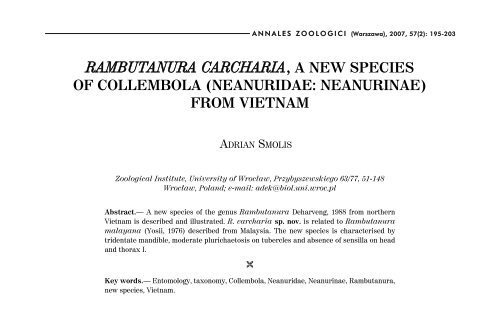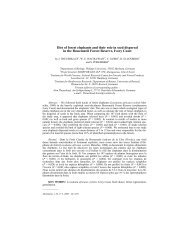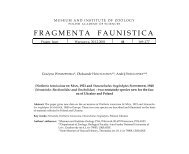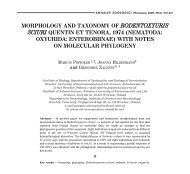RAMBUTANURA CARCHARIA, A NEW SPECIES OF COLLEMBOLA
RAMBUTANURA CARCHARIA, A NEW SPECIES OF COLLEMBOLA
RAMBUTANURA CARCHARIA, A NEW SPECIES OF COLLEMBOLA
You also want an ePaper? Increase the reach of your titles
YUMPU automatically turns print PDFs into web optimized ePapers that Google loves.
A N N A L E S Z O O L O G I C I (Warszawa), 2007, 57(2): 195-203<br />
<strong>RAMBUTANURA</strong> <strong>CARCHARIA</strong>, A <strong>NEW</strong> <strong>SPECIES</strong><br />
<strong>OF</strong> <strong>COLLEMBOLA</strong> (NEANURIDAE: NEANURINAE)<br />
FROM VIETNAM<br />
ADRIAN SMOLIS<br />
Zoological Institute, University of Wrocław, Przybyszewskiego 63/77, 51-148<br />
Wrocław, Poland; e-mail: adek@biol.uni.wroc.pl<br />
Abstract.— A new species of the genus Rambutanura Deharveng, 1988 from northern<br />
Vietnam is described and illustrated. R. carcharia sp. nov. is related to Rambutanura<br />
malayana (Yosii, 1976) described from Malaysia. The new species is characterised by<br />
tridentate mandible, moderate plurichaetosis on tubercles and absence of sensilla on head<br />
and thorax I.<br />
�<br />
Key words.— Entomology, taxonomy, Collembola, Neanuridae, Neanurinae, Rambutanura,<br />
new species, Vietnam.
A N N A L E S Z O O L O G I C I (Warszawa), 2007, 57(2): 205-210<br />
BRACHYDESMUS NEVOI, A <strong>NEW</strong> MILLIPEDE<br />
FROM ISRAEL (DIPLOPODA: POLYDESMIDA)<br />
SERGEI GOLOVATCH 1 and JOLANTA WYTWER 2<br />
1Institute for Problems of Ecology and Evolution, Russian Academy of Sciences,<br />
Leninsky pr. 33, Moscow 119071, Russia; e-mail: sgol@orc.ru<br />
2Museum and Institute of Zoology, Polish Academy of Sciences, Wilcza 64,<br />
00-679 Warsaw, Poland; e-mail: jolawyt@miiz.waw.pl<br />
Abstract.— Brachydesmus nevoi sp. nov. is described from several places in Israel. This<br />
new species shows modest but evident morphism/variation in structure of the gonopod<br />
exomere, being the first in the family Polydesmidae to be recorded in the Levant. It seems<br />
to be particularly close to several Balkan congeners, but differs in lack of any teeth on the<br />
gonopod femoral and/or prefemoral parts and, above all, in a remarkably prominent<br />
accessory seminal chamber.<br />
Key words.— Diplopoda, Brachydesmus, new species, morphism, Israel.<br />
�
A N N A L E S Z O O L O G I C I (Warszawa), 2007, 57(2): 211-219<br />
A SPLIT-FOOTED LACEWING AND TWO EPIOSMYLINES<br />
FROM THE JURASSIC <strong>OF</strong> CHINA (NEUROPTERA)<br />
DONG REN 1 and MICHAEL S. ENGEL 2<br />
1Department of Biology, Capital Normal University, 105 Xisanhuanbeilu, Beijing<br />
100037, People's Republic of China; e-mail: rendong@cnu.edu.cn<br />
2Division of Entomology (Paleoentomology), Natural History Museum, and<br />
Department of Ecology and Evolutionary Biology, 1501 Crestline<br />
Drive-Suite #140,<br />
University of Kansas, Lawrence, Kansas 66049-2811; and Division<br />
of Invertebrate Zoology, American Museum of Natural History,<br />
Central Park West at 79th Street, New York, New York 10024-5192, United States;<br />
e-mail: msengel@ku.edu<br />
Abstract.— The first Chinese fossil of the family Nymphidae (Neuroptera: Myrmeleontiformia)<br />
is briefly described and figured along with two episomyline Osmylidae, a generally<br />
plesiomorphic group which can be easily confused with nymphids when only wings are<br />
known. Four new species and three new genera are characterized from Jurassic deposits<br />
of the Jiulongshan Formation (Daohugou Biota), Inner Mongolia, China. New genera are<br />
Liminympha (Nymphidae), Enodinympha (Osmylidae), and Nilionympha (Osmylidae),<br />
while the new species are Liminympha makarkini, Enodinympha translucida,<br />
Nilionympha pulchella, and N. imperfecta.<br />
�<br />
Key words.— Neuroptera, Myrmeleontiformia, Nymphidae, new genus, new species,<br />
Jurassic, Mesozoic, Osmylidae, Epiosmylinae, China.
A N N A L E S Z O O L O G I C I (Warszawa), 2007, 57(2): 221-225<br />
A <strong>NEW</strong> FOSSIL GENUS <strong>OF</strong> SIPHLONURIDAE<br />
(INSECTA: EPHEMEROPTERA) FROM THE DAOHUGOU,<br />
INNER MONGOLIA, CHINA<br />
JIANDONG HUANG 1 , YUSHUANG LIU 1 ,<br />
NINA D. SINITSHENKOVA 2 and DONG REN 1*<br />
1College of Life Science, Capital Normal University, Beijing 100037, China<br />
2Palaeontological Institute of the Russian Academy of Sciences, Profsoyuznaya<br />
123, Moscow, Russia<br />
*Corresponding author<br />
Abstract.— A new genus and species Multiramificans ovalis gen. and sp. nov. of the<br />
family Siphlonuridae s.l., is described from the Middle Jurassic Jiulongshan Formation of<br />
the Daohugou, Inner Mongolia in China. Detailed description and illustration of the<br />
specimen along with a brief review of fossil Siphlonuridae s.l. are given. The problems of<br />
association between nymphs and adults, and palaoenvironment are briefly discussed.<br />
�<br />
Key words.— Ephemeroptera, Siphlonuridae, Multiramificans, Multiramificans<br />
ovalis, new genus, new species, fossils, Daohugou, Middle Jurassic, China.
A N N A L E S Z O O L O G I C I (Warszawa), 2007, 57(2): 227-230<br />
NEOMEDETERA, A <strong>NEW</strong> GENUS IN THE SUBFAMILY<br />
MEDETERINAE (DIPTERA: DOLICHOPODIDAE)<br />
FROM CHINA<br />
YAJUN ZHU 1 , DING YANG 1, * and PATRICK GROOTAERT 2<br />
1Department of Entomology, China Agricultural University, Beijing 100094,<br />
China; e-mail: dyangcau@yahoo.com.cn<br />
2Department of Entomology, Royal Belgian Institute of Natural Science,<br />
Vautierstreet 29, B-1000 Brussels, Belgium<br />
* Corresponding author<br />
Abstract.— A new genus, Neomedetera, from China is erected and type species<br />
Neomedetera membranacea sp. nov. is described. The new genus has reduced 8 th<br />
sternum and basoventral foramen as its unusual characters. A key to separate the<br />
Palaearctic and Oriental genera of Medeterinae is presented.<br />
Key words.— Dolichopodidae, Medeterinae, Neomedetera, new genus, China.<br />
�
A N N A L E S Z O O L O G I C I (Warszawa), 2007, 57(2): 231-247<br />
<strong>NEW</strong> BEETLES (INSECTA: COLEOPTERA:<br />
ARCHOSTEMATA) FROM THE LATE MESOZOIC<br />
<strong>OF</strong> NORTH CHINA<br />
JINGJING TAN, DONG REN * , CHUNGKUN SHIH<br />
College of Life Science, 105 Xisanhuanbeilu, Haidian District, Capital Normal<br />
University, Beijing 100037, China<br />
* Corresponding Author: College of Life Science, Capital Normal University,<br />
105 Xisanhuanbeilu, Haidian District, Beijing 100037, China<br />
e-mail: rendong@mail.cnu.edu.cn<br />
Abstract.— Two new genera including four new species of fossil beetles assigned to the<br />
family Schizophoridae – Menopraesagus explanatus gen. and sp. nov., M. oxycerus<br />
gen. and sp. nov., M. grammicus gen. and sp. nov. and Homocatabrycus liui gen. and<br />
sp. nov., and a new genus including one new species assigned to the family Ademosynidae<br />
– Lasiosyne euglyphea gen. and sp. nov. are described. All of them are collected from the<br />
Middle Jurassic Jiulongshan Formation of eastern Inner Mongolia, China. Another two new<br />
fossil species referable to the genus Tetraphalerus of family Ommatidae, Tetraphalerus<br />
latus sp. nov. and Tetraphalerus curtinervis sp. nov., are reported from the Jehol Biota<br />
of western Liaoning, China.<br />
�<br />
Key words.— Schizophoridae, Ademosynidae, Ommatidae, Jiulongshan Formation, Yixian<br />
Formation, China, new genera, new species, fossil beetles.
A N N A L E S Z O O L O G I C I (Warszawa), 2007, 57(2): 249-255<br />
A CONTRIBUTION TO THE NEOTROPICAL GENUS<br />
ACINACES GERSTAECKER (COLEOPTERA:<br />
ENDOMYCHIDAE) WITH DESCRIPTIONS <strong>OF</strong> <strong>NEW</strong> <strong>SPECIES</strong><br />
K. WIOLETTA TOMASZEWSKA<br />
Muzeum i Instytut Zoologii PAN; Wilcza 64, 00-679 Warszawa, Poland<br />
e-mail: wiolkat@miiz.waw.pl<br />
Abstract.— Two new species of the Neotropical genus Acinaces (A. nataliae and<br />
A. humeralis) from Peru are described, diagnosed and illustrated. The following new<br />
status is proposed: A. stroheckeri Tomaszewska, 2003 (=A. lebasii stroheckeri<br />
Tomaszewska, 2003). Notes on the colour variation of A. laceratus, the most variable<br />
species of the genus are provided. The key to the known species of the genus is updated.<br />
�<br />
Key words.— Entomology, taxonomy, new species, key, Coleoptera, Cucujoidea, Lycoperdininae,<br />
Acinaces.
A N N A L E S Z O O L O G I C I (Warszawa), 2007, 57(2): 257-266<br />
TAXONOMICAL CHANGES IN PALAEARCTIC LUPERINI<br />
(COLEOPTERA: CHRYSOMELIDAE: GALERUCINAE)<br />
JAN BEZDĚK<br />
Mendel University of Agriculture and Forestry, Department of Zoology,<br />
Zemědělská 1, 613 00 Brno, Czech Republic; e-mail: bezdek@mendelu.cz<br />
Abstract.— Based on the examination of type material and study of literature sources, the<br />
following nomenclatural changes are proposed: Nymphius stylifer ssp. ogloblini<br />
(Bogatchev, 1947) (stat. nov.); Scelolyperus Crotch, 1874 = Tuomuria Chen et Jiang,<br />
1985 (syn. nov.) = Tuomueria Chen et Jiang, 1986 (syn. nov.); Scelolyperus tibialis<br />
(Chen et Jiang, 1985) (comb. nov.) = Tuomueria tibialis Chen et Jiang, 1986 (syn. nov.)<br />
= Scelolyperus kroliki Borowiec, 2005 (syn. nov.); Calomicrus apicalis Demaison,<br />
1891 = C. peyroni (Pic, 1899) (syn. nov.); C. albanicus (Csiki, 1940) (comb. nov.)<br />
= C. macedonicus (Tomov, 1975) (syn. nov.); C. syriacus (Weise, 1924) = Monolepta<br />
anatolica Bezděk, 1998 (syn. nov.). Calomicrus heydeni (Weise, 1900) is confirmed as<br />
synonym of C. lividus (Joannis, 1865). Luperus sibiricus Csiki, 1916 proved to be<br />
Luperomorpha Weise, 1887, thus it is transferred from Galerucinae to Alticinae.<br />
Lectotypes are designated for Luperus albanicus Csiki, 1940, L. brevicollis Weise, 1898,<br />
L. cous Weise, 1889 and L. rhilensis Weise, 1900. The drawings of male genitalia are<br />
provided for most of the species studied.<br />
�<br />
Key words.— Taxonomy, new synonymy, new combination, status novum, lectotype designation,<br />
Coleoptera, Chrysomelidae, Galerucinae, Alticinae, Luperini, Calomicrus, Luperus,<br />
Luperomorpha, Nymphius, Monolepta, Scelolyperus, Tuomeria, Tuomueria,<br />
Palaearctic Region.
A N N A L E S Z O O L O G I C I (Warszawa), 2007, 57(2): 267-270<br />
THREE <strong>NEW</strong> ORIENTAL <strong>SPECIES</strong> <strong>OF</strong> THE GENUS<br />
FALSOTITHASSA PIC, 1934 (COLEOPTERA:<br />
TENEBRIONIDAE: LUPROPINI)<br />
WOLFGANG SCHAWALLER*<br />
Staatliches Museum für Naturkunde, Rosenstein 1, D-70191 Stuttgart, Germany;<br />
e-mail: schawaller.smns@naturkundemuseum-bw.de<br />
Abstract.— Three new species of the genus Falsotithassa Pic, 1934 (Tenebrionidae:<br />
Lupropini) are described: Falsotithassa gigantea sp. nov. from Thailand and Laos,<br />
Falsotithassa sulawesica sp. nov. from Sulawesi and Falsotithassa thailandica sp.<br />
nov. from Thailand. Some new faunistical data of and taxonomic remarks to known species<br />
are added. At present, 10 species are recognized as valid within the genus, occurring<br />
exclusively in the Oriental region.<br />
�<br />
Key words.— Coleoptera, Tenebrionidae, Lupropini, Falsotithassa, new species, taxonomy,<br />
distribution.
A N N A L E S Z O O L O G I C I (Warszawa), 2007, 57(2): 271-274<br />
A <strong>NEW</strong> <strong>SPECIES</strong> <strong>OF</strong> THE GENUS ASIDA LATREILLE,<br />
1802 FROM FRENCH SOUTHERN ALPS<br />
(INSECTA: COLEOPTERA: TENEBRIONIDAE)<br />
FABIEN SOLDATI<br />
Muséum d'Histoire Naturelle, 1, rue Chrestien de Troyes, F-10000 Troyes, France<br />
e-mail: asida.soldati@wanadoo.fr<br />
Abstract.— Asida christianperezi, new species from French Southern Alps is described<br />
and illustrated. To complete the description, ecological and biogeographical comments are<br />
given.<br />
�<br />
Key words.— Insecta, Coleoptera, Tenebrionidae, Asidini, Asida christianperezi, new<br />
species, France, Southern Alps.
A N N A L E S Z O O L O G I C I (Warszawa), 2007, 57(2): 275-306<br />
RÉVISION DES GENRES GONIADERA PERTY, 1830<br />
ET MICROGONIADERA PIC, 1913 (COLEOPTERA:<br />
TENEBRIONIDAE: LAGRIINAE: GONIADERINI)<br />
JULIO FERRER 1 and THIERRY DELATOUR 2<br />
1Swedish Museum of Natural History, Department of Entomology, 10405<br />
Stockholm, Sweden<br />
210 Chemin Planet, CH-1188 Gimel VD. Suisse<br />
Abstract.— The types of all species belonging to the genus Goniadera Perty, 1830 are<br />
studied. The lectotype of Melandrya repanda Fabricius, 1801, is designated. Eight new<br />
species of Goniadera are described: Goniadera ardoini sp. nov., Brasil, G. barclayi sp.<br />
nov., Brasil and Peru, G. girardi sp. nov., G. jaegeri sp. nov., G. merkli sp. nov., Brasil,<br />
G. onorei sp. nov. from Ecuador, G. peseudorepanda sp. nov. from Costa Rica and<br />
Mexico and G. floresi sp. nov. from Argentina. Goniadera simplex Fairmaire, 1889 is<br />
transferred to Aemyone Bates, 1868, but this genus is degraded to sub-genus of<br />
Goniadera. The name Goniadera (Aemyone) simplex (Fairmaire, 1889) comb. nov., is<br />
proposed. The genus Opatresthes Gebien, 1928 is studied and considered as another subgenus<br />
of Goniadera. Goniadera tuberculifera Fairmaire, 1889 is trasferred to this<br />
genus, the new name Goniadera (Opatresthes) tuberculifera (Fairmaire, 1889) comb.<br />
nov., is proposed. A new species from Nicaragua: Goniadera (Opatresthes) maesi sp.<br />
nov. is described. A key to separate all sub-genera and species is provided. Etaceta<br />
aeneicolor Fairmaire, by monotypy is excluded from the tribu Goniaderini and its position<br />
in the tribu Lupropini sensu Ardoin (1969) is confirmed. New synonymies are recognised:<br />
Goniadera simplex Fairmaire (= Aemyone bordoni Marcuzzi, 1994) syn. nov.,<br />
Aemyone cariosa Fairmaire, 1873 (= Anaedus striatipennis Pic, 1917) syn. nov. and<br />
(Aemyone silvanae Marcuzzi, 1994) syn. nov.; Aemyone crenata Champion, 1886<br />
becoming homonymic with Goniadera crenata Perty, 1830 is changed in Goniadera<br />
(Aemyone) championi nom. nov.<br />
Résumé.— La totalité des types des espèces du genre Goniadera Perty, 1830 sont étudiés.<br />
Le lectotype de Melandrya repanda Fabricius, 1801 est désigné. Huit espèces nouvelles<br />
sont décrites: Goniadera ardoini sp. nov. du Brésil, G. barclayi du Brésil et Pérou,<br />
G. girardi sp. nov., G. jaegeri sp. nov. et G. merkli sp. nov., Brésil, G. onorei sp. nov.<br />
du Equateur, pseudorepanda sp. nov. du Costa Rica et du Mexique, et G. floresi sp. nov.,<br />
d´Argentine. Goniadera simplex Fairmaire, 1889 est transféré dans le genre Aemyone<br />
Bates, 1868, considéré comme un sous-genre de Goniadera, le nom Goniadera (Aemyone)<br />
simplex (Fairmaire) comb. nov. est proposée. Goniadera tuberculifera Fairmaire,<br />
1889 est transférée dans le genre Opatresthes Gebien, 1928, qui est égalément considéré<br />
comme un sous-genre de Goniadera. Le nouveau nom Goniadera (Opatresthes) tuberculifera<br />
(Fairmaire, 1889) comb. nov. est proposé. Une nouvelle espèce du Nicaragua,<br />
Goniadera (Opatresthes) maesi sp. nov. est décrite. Une clé pour séparer tous les sousgenres<br />
et espèces est donnée. Etaceta aeneicolor Fairmaire est exclu de la tribu des Goniaderini<br />
et sa position dans celle des Lupropini sensu Ardoin (1969) est confirmée. Des synonymies<br />
nouvelles sont établies: Goniadera simplex Fairmaire (= Aemyone bordoni<br />
Marcuzzi, 1994) syn. nov., Aemyone cariosa Fairmaire, 1873 (= Anaedus striatipennis<br />
Pic, 1917) syn. nov. et (= Aemyone silvanae Marcuzzi, 1994) syn. nov Aemyone crenata<br />
Champion, 1886 tombe en homonymie avec Goniadera crenata Perty, 1830 le nom est<br />
changé, devenant Goniadera (Aemyone) championi nom. nov.<br />
�<br />
Mots clé.— révision, nouvelles espèces, région néotropicale, Coleoptera, Tenebrionidae,<br />
Lagriinae, Goniaderini, Goniadera, Microgoniadera .
A N N A L E S Z O O L O G I C I (Warszawa), 2007, 57(2): 307-318<br />
THE HINDWING VENATION AND ITS TAXONOMIC<br />
VALUE IN AFROTROPICAL SCUTELLERIDAE<br />
(HEMIPTERA: HETEROPTERA)<br />
JOANNA CZAJA<br />
Department of Biosystematics, University of Opole, Oleska 22, 45-052 Opole,<br />
Poland; e-mail: heyna@uni.opole.pl<br />
Abstract.— The metathoracic wing venation in 41 species of 18 genera of Afrotropical<br />
Scutelleridae was studied and the results are presented and illustrated. Four main types of<br />
venational pattern can be recognized. The hindwing venation in Scutelleridae has also been<br />
compared with that of some other Pentatomoidea (Cydnidae, Dinidoridae, Pentatomidae<br />
and Tessaratomidae). Furthermore, the taxonomic value of metathoracic wing venation in<br />
the Afrotropical Scutelleridae has been discussed.<br />
�<br />
Key words.— Hemiptera, Heteroptera, Scutelleridae, hindwing venation, taxonomy, morphology,<br />
Afrotropical Region.
A N N A L E S Z O O L O G I C I (Warszawa), 2007, 57(2): 319-324<br />
DO DEPENDENT FOUNDRESSES <strong>OF</strong> FORMICA<br />
PRATENSIS RETZ. (HYMENOPTERA: FORMICIDAE)<br />
NEED A ‘PASS’ TO BE ADOPTED BY A HOST COLONY?<br />
WOJCIECH CZECHOWSKI and ALEXANDER RADCHENKO<br />
Laboratory of Social and Myrmecophilous Insects, Museum and Institute<br />
of Zoology, Polish Academy of Sciences, Wilcza 64, 00-679 Warszawa, Poland<br />
e-mails: wcz@miiz.waw.pl, agradchenko@hotmail.com<br />
Abstract.— Dealate gynes of Formica pratensis Retz., after their nuptial flight, were<br />
observed heading for colonies of their potential temporary host species in a sand dune<br />
habitat in southern Finland. Two F. pratensis gynes, one within a nest area of Formica<br />
cinerea Mayr, and one close to a nest of Formica lusatica Seifert, were noticed walking<br />
with a F. cinerea and F. lusatica worker respectively in their mandibles. So far such<br />
peculiar behaviour preceding dependent colony founding has only been known in gynes of<br />
the subgenus Chthonolasius Ruzs., obligate temporary social parasites. Observations<br />
were carried on in June 2006.<br />
�<br />
Key words.— Ants, Formica pratensis, F. cinerea, F. lusatica, F. sanguinea, temporary<br />
social parasitism, dependent colony founding, chemical camouflage.
A N N A L E S Z O O L O G I C I (Warszawa), 2007, 57(2): 325-330<br />
MERMITHID INFESTATION STRIKINGLY ALTERS<br />
THE MORPHOLOGY <strong>OF</strong> MYRMICA RUBRA (L.)<br />
(HYMENOPTERA: FORMICIDAE): POSSIBLE<br />
TAXONOMICAL INVOLVEMENTS<br />
WOJCIECH CZECHOWSKI, ALEXANDER RADCHENKO<br />
and WIESŁAWA CZECHOWSKA<br />
Laboratory of Social and Myrmecophilous Insects, Museum and Institute of Zoology,<br />
Polish Academy of Sciences, Wilcza 64, 00-679 Warsaw, Poland; e-mails:<br />
wcz@miiz.waw.pl, agradchenko@hotmail.com, w.czechowska@miiz.waw.pl<br />
Abstract.— A colony of Myrmica rubra (L.) parasitised by the mermithid nematodes was<br />
found in Pieniny Mts (S Poland). About 25% of the adult workers were infested, and their<br />
body, apart from a visibly distended gaster, was modified to an extent previously unknown<br />
in mermithised Myrmica ants (shape of body parts, sculpture, pilosity). The morphology of<br />
infested and non-infested individuals was compared using standard measurements and<br />
indices employed in taxonomy of the genus Myrmica Latr. Mermithogenic modifications of<br />
body structure in Myrmica species are signalled to be the cause of the possible taxonomic<br />
problems and mistakes.<br />
�<br />
Key words.— Ants, Myrmica rubra, parasites, Nematoda, Mermithidae, morphology,<br />
teratology, taxonomy.
A N N A L E S Z O O L O G I C I (Warszawa), 2007, 57(2): 331-340<br />
ONE <strong>NEW</strong> GENUS AND FOUR <strong>NEW</strong> <strong>SPECIES</strong><br />
<strong>OF</strong> OONOPID SPIDERS FROM SOUTHWEST CHINA<br />
(ARANEAE: OONOPIDAE)<br />
YANFENG TONG 1, 2 and SHUQIANG LI 1*<br />
1 Institute of Zoology, Chinese Academy of Sciences, Beijing 100080, China<br />
2 Graduate School of Chinese Academy of Sciences, Beijing 100039, China<br />
* Corresponding author; e-mail: lisq@ioz.ac.cn<br />
Abstract.— Four new species of oonopid spiders are described from southwest China. Two<br />
of these are placed in the new genus Trilacuna gen. nov.: T. angularis sp. nov. and<br />
T. rastrum sp. nov. (type species). Trilacuna gen. nov. is characterized by the enlarged<br />
male palpal femur, the complicated embolus-conductor complex, the branched male endites<br />
and the notched labium. A further two species are Camptoscaphiella tuberans sp. nov.<br />
and Gamasomorpha barbifera sp. nov. A key to 10 genera and 23 species of the currently<br />
known Chinese oonopid spiders is given.<br />
�<br />
Key words.— Oonopidae, Camptoscaphiella, Gamasomorpha, Trilacuna, new genus,<br />
new species, China.
A N N A L E S Z O O L O G I C I (Warszawa), 2007, 57(2): 341-350<br />
DRACONARIUS SPIDERS IN CHINA, WITH DESCRIPTION<br />
<strong>OF</strong> SEVEN <strong>NEW</strong> <strong>SPECIES</strong> COLLECTED FROM CAVES<br />
(ARANEAE: AMAUROBIIDAE)<br />
XIANG XU and SHUQIANG LI*<br />
Institute of Zoology, Chinese Academy of Sciences, Beijing 100080101, P.R. China<br />
* corresponding author; e-mail: lisq@ioz.ac.cn<br />
Abstract.— Cave Draconarius spiders in China were rarely reported. In the present<br />
paper, seven new Draconarius species collected from caves in China are described and<br />
illustrated. They are D. auriformis sp. nov., D. brachialis sp. nov., D. tongi sp. nov.,<br />
D. ovillus sp. nov., D. specialis sp. nov., D. spirallus sp. nov. and D. tubercularis sp.<br />
nov. Distribution maps of Draconarius spiders are provided.<br />
Key words.— Taxonomy, Draconarius, Amaurobiidae, new species, cave.<br />
�
A N N A L E S Z O O L O G I C I (Warszawa), 2007, 57(2): 351-361<br />
COCCEUPODES LONGISOLENIDIATUS,<br />
A <strong>NEW</strong> MITE <strong>SPECIES</strong> <strong>OF</strong> THE FAMILY EUPODIDAE<br />
(ACTINOTRICHIDA: ACTINEDIDA: EUPODOIDEA)<br />
FROM POLAND<br />
KATARZYNA JESIONOWSKA<br />
Department of Invertebrate Zoology and Limnology, University of Szczecin,<br />
ul. Wąska 13, PL-71-415 Szczecin, Poland<br />
e-mail: Katarzyna.Jesionowska@univ.szczecin.pl<br />
Abstract.— In this paper, Cocceupodes longisolenidiatus, a new mite from the family<br />
Eupodidae is described and illustrated on the basis of material collected from Poland.<br />
A comprehensive account of the morphology of the body, i.e. idiosoma, gnathosoma, legs<br />
with setae and solenidia, is given.<br />
�<br />
Key words.— Acari, Actinedida, Eupodoidea, Eupodidae, Cocceupodes longisolenidiatus,<br />
description, new mite species, morphology, Poland.






